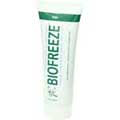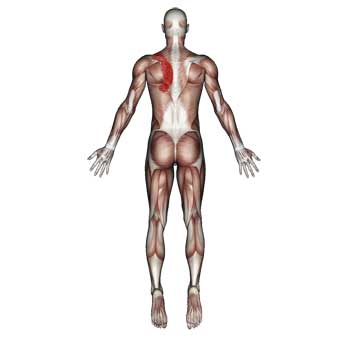The infraspinatus muscle is one of four rotator cuff muscles located in the shoulder. It is one of the most problematic muscles in the body. It is used in many movements of the arm and is one of the shoulder muscles that hold the ball of the upper arm bone (humerus) in the socket of the shoulder joint.
The muscle contributes to pain on the outside of the shoulder and arm that can descend to the hand. Pain may also occur around the inside edge of the shoulder blade (scapula). It can also refer pain up into the back of the neck at the base of the skull.
Two other indicators of problems with the infraspinatus are stiffness in the shoulder and finding it difficult to move the arm. You will also find that your shoulder and arm tire easily.
Where Is The Infraspinatus?

The infraspinatus muscle covers the back of the shoulder blade (scapula). It connects the shoulder blade to the upper arm (head of the humerus).
What Movements Does It Control?
- Twists the arm away from the body (external rotation)
- Assists in stabilizing the shoulder joint
Looking for detailed muscle anatomy? The Infraspinatus Muscle Anatomy Page has origin, insertion, innervation, and blood supply information. It also lists agonists and antagonists for each muscle action.
Advertisement
Infraspinatus Muscle Trigger Points Symptoms:

Though the muscle is located in the back of the shoulder, the most common pain symptom is a deep aching in the front of the shoulder. The shoulder is stiff, and you experience limited movement in the arm. Pain is often felt around the inside edge of the shoulder blade. Referred pain may travel down the outside of the arm and continue down into the hand.
The symptoms:
- Pain deep in the front of the shoulder
- Pain going down the front and outside of the arm, sometimes going down into the hand.
- Pain going up the back of the neck to the base of the skull
- Pain in the upper back at the inside edge of the shoulder blade
- Weakness and stiffness in the shoulder and arm
- Difficulty reaching the arm behind the body and reaching into a back hip pocket
- Pain when raising the arm to brush your hair
 Sombra Warm Therapy Gel is recommended for relaxing muscles and relieving pain. It warms without the burning heat of other gels. An excellent choice for pain caused by trigger points, muscle/joint over-use and stiffness, and arthritis. (Not sold in stores)
Sombra Warm Therapy Gel is recommended for relaxing muscles and relieving pain. It warms without the burning heat of other gels. An excellent choice for pain caused by trigger points, muscle/joint over-use and stiffness, and arthritis. (Not sold in stores)
 Biofreeze Professional Gel is recommended by medical professionals and trainers for the pain and symptoms of muscle strains. It provides excellent pain relief and may help reduce inflammation caused by a strain.
Biofreeze Professional Gel is recommended by medical professionals and trainers for the pain and symptoms of muscle strains. It provides excellent pain relief and may help reduce inflammation caused by a strain.
What Causes Infraspinatus Trigger Points To Develop?
The infraspinatus plays an integral role in lifting and holding the arms up and out away from the body. Therefore, any activities that involve this can be problematic, cause pain, and lead to trigger point development.
Sports that require constant twisting and rotation motions of the arm often cause trigger points to develop. If the TrPs are not deactivated, it will limit if not stop the time spent playing and competing in sports.
Other causes:
- Keeping the arms overhead for extended periods
- Painting overhead
- Keeping the arms extended in front of the body for extended periods
- Driving with hands on top of the steering wheel
- Keyboarding and using the mouse on the computer
Sports
- Swimmers
- Throwing a ball or swinging motions
- Tennis
- Baseball
- Football
- Basketball
How To Avoid Development of Trigger Points In The Infraspinatus
- If you play sports, don’t overdo it. Practice/play within your fitness level.
- Warm-up your body and take breaks to rest and stretch out the upper body.
- If you are doing an overhead activity that requires you to keep your arms up and out, such as painting a ceiling, use a step ladder or other reaching tools. Find tools that will give your shoulders and arms a break. It may be more time-consuming, but it could save you from pain. At the very least, take breaks and rest your arms and shoulders.
- If you work at a desk, be sure your chair has arms and supports your arms while working. This not only reduces pain and stiffness in your shoulders but also in your neck and back.
TWD Recommends
 If you are an athlete who participates in sports or has a job that stresses the shoulder muscles, you should consider having a cold therapy wrap on hand for treatments when you feel soreness and pain. This will help decrease inflammation in the muscles and around the shoulder joint and may prevent overuse injury or other damaging injuries to your shoulder.
If you are an athlete who participates in sports or has a job that stresses the shoulder muscles, you should consider having a cold therapy wrap on hand for treatments when you feel soreness and pain. This will help decrease inflammation in the muscles and around the shoulder joint and may prevent overuse injury or other damaging injuries to your shoulder.
Infraspinatus Trigger Point Treatment
You can learn to treat TrPs in the infraspinatus using The Trigger Point Therapy Workbook as a guide. The workbook explains trigger points and includes diagrams of the trigger points located in each muscle. In addition, instructions for treatment are given for each muscle. It is an excellent resource for anyone who wants to learn about muscle pain and treat it.
Since the muscle is not easy to access, you will need a tool for treatment. If balance and coordination are not a problem, massage balls are recommended. You place the ball between a wall and the back of the shoulder to apply pressure and massage.
If balance or mobility is a problem, you can also use the TheraCane Massage Tool. The cane can be used while sitting or standing and is easy for most people to use.
Another option is to find a chiropractor, massage therapist, or physical therapist trained in trigger point therapy and show you how to self-treat.
TWD Recommends

Doctors and physical therapists often recommend TENS to relax muscles and ease the pain. The Belifu TENS Unit Muscle Stimulator is a great choice for treating shoulder, arm, and upper back pain.
How Long Before I Feel A Reduction In Pain?
Infraspinatus trigger points are easily treated and respond quickly to TrP treatment. Most people will notice a difference in just a few treatments.
For optimal results, do several 1-2 minute treatments throughout the day. If you notice the muscle becoming sore, reduce the number of treatments and the pressure used during treatment.
Be consistent with your treatment plan and continue until the trigger point is deactivated and no longer produces pain or other symptoms.
Interesting facts:
- The infraspinatus is one of the most problematic muscles in the human body. Along with the three other muscles that make up the rotator cuff, it is responsible for shoulder movements and holding the shoulder joint together.
- Trigger points in the infraspinatus can render the shoulder almost immobile. As a result, it is painful to raise the arm, bring the arm across in front of the body or bend the arm behind it. The inability to do these movements is often diagnosed as frozen shoulder.
Infraspinatus muscle pain and symptoms can be similar to, contribute to, and be affected by these medical diagnoses:
- Adhesive capsulitis
- Frozen shoulder
- Rotator cuff tear
- Rotator cuff tendinitis
- Brachial plexus injuries
- Thoracic outlet syndrome
- Subdeltoid bursitis
- Bicipital tendinitis
- Dislocation of the glenohumeral joint
- Cervical arthritis or spurs
- Supraspinatus tendinitis
- Shoulder pointer
- Shoulder Sprain / Strain injury
- C5 C6 C7 radiculopathy
Advertisement
Other muscles that should be considered and examined:
Satellite trigger points associated with the infraspinatus muscle:
If you have trigger points in the infraspinatus, you have likely developed satellite trigger points in other muscles. TrPs in these muscles may also cause the development of satellite trigger points in the infraspinatus. Check all these muscles for complete treatment.
- Anterior deltoid
- Supraspinatus
- Biceps brachii
- Teres minor
- Teres major
- Latissimus dorsi
- Subscapularis
- Pectoralis major
Find additional muscles that may contribute to these symptoms:
ADHESIVE CAPSULITIS | ARM PAIN | BICIPITAL TENDONITIS | BRACHIAL PLEXUS ENTRAPMENT | FROZEN SHOULDER | GLENOHUMERAL JOINT SEPARATION | HAND PAIN | NECK PAIN | ROTATOR CUFF | SHOULDER PAIN | SHOULDER POINTER | SUBDELTOID BURSITIS | SUPRASPINATUS TENDINITIS | THORACIC OUTLET SYNDROME | UPPER BACK PAIN



